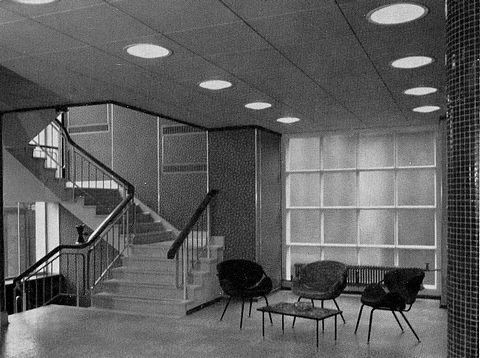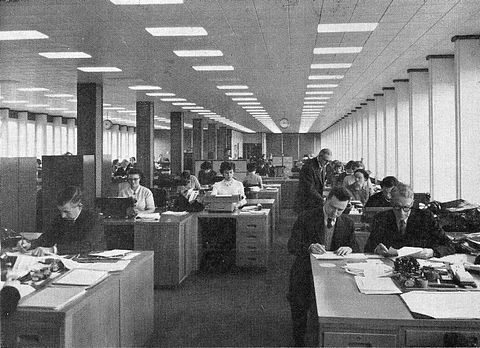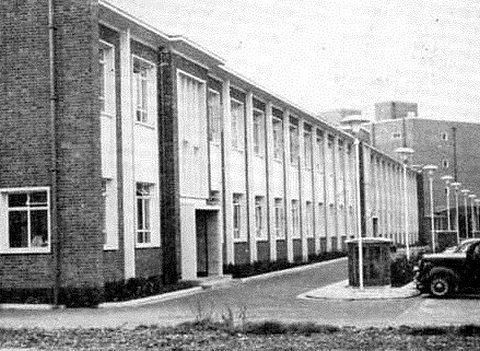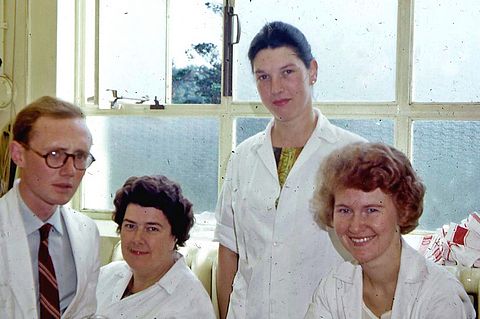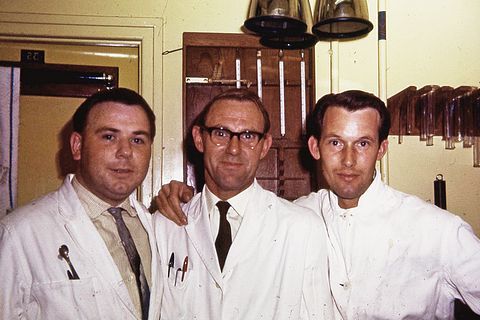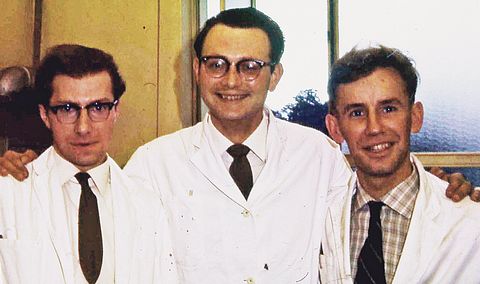Research in Photography;
A Visit To An Ilford Laboratory
The following article
first appeared in the February 1958 issue of Modern Camera Magazine
(MCM).
A most interesting visit was
paid by the Editor of this magazine recently to the new Ilford
Research Laboratory at Brentwood, Essex, when the technical press
was invited to view the premises a few days before His Royal
Highness the Duke of Edinburgh honoured the company by himself
inspecting what is undoubtedly one of the finest research laboratories
to have been built since the war.
Named the Ramsden Laboratory
after the late Colonel Ramsden, who was closely associated with
the early expansion of the company, it is one of the three principal
Ilford laboratories in this country. The building houses three
sections devoted respectively to physics, chemistry and tests.
The total floor area of 30,000
square feet on two floors is of the most modern construction,
with steel framework encased in concrete. Inside, the wall finish
is polyvinyl chloride fabric applied to the hardwall plaster
and the floors throughout have plastic tiles. In all rooms where
there may be corrosive, or stain-effecting chemicals, the walls
are finished with a special protective paint and in the darkrooms,
where "wet" processes are of special importance, the
floors and walls are lined with asphalt. The laboratory furniture
is designed in units; the tops of benches and the shelving being
cased with melamine plastic; chemical-resisting and easy to clean.
All sinks are lined with rubber and a special drainage system
allows the waste liquids to be treated to recover silver residue.
One of the sections which was
most interesting to visitors was that devoted to emulsions, and
a demonstration was given showing the principles of the preparation
of an emulsion and its final coating on the flexible base. Naturally,
this demonstration, which took place in full light, produced
an emulsion which was worthless photographically because it was
immediately fogged in the demonstration, but yet it gave a good
idea of what happens in practice.
Two separate containers contained
respectively solutions of silver nitrate and ammonium bromide.
These were then together run into a gelatine solution, the mixture
being mechanically stirred, whereupon a yellowish precipitate
of silver bromide was formed. After the addition of a further
small amount of ammonia, the emulsion was warmed to the correct
temperature, which was kept constant for a short period, causing
a growth of the crystals suspended in the gelatine. The custard-like
mixture was subsequently poured into a trough and a band of film
base was continuously coated by passing it over a roller immersed
in the emulsion, which was thus transferred to the base.
In commercial production, of
course, sundry additions of sensitizers and other chemicals are
made and the whole process is carried out in complete darkness.
|

|
Entrance to the New Laboratory
at Brentwood |
|
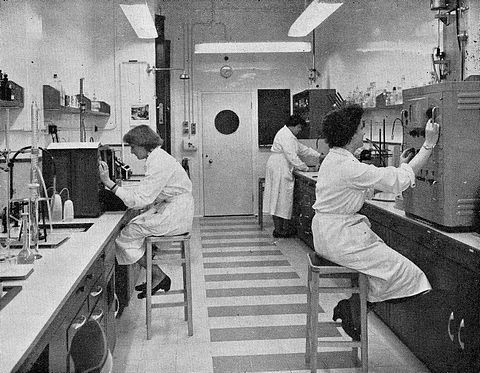
|
The Whole Building is Temperature-Controlled
and Air-Conditioned |
The lighting system in the
darkroom is indirect and can be seen in our illustration (right).
Notice groups of what look like inverted funnels hanging from
the ceiling. These are in sets of three, any one lamp of which
can be switched on according to the work being done. If the sensitivity
of the material being dealt with is affected only by blue light
then the safelight used is amber coloured. If, as with an emulsion
such as Plastika, it is sensitive to both blue and green, the
safelighting is red, while for panchromatic work a very dim green
light can be used.
|
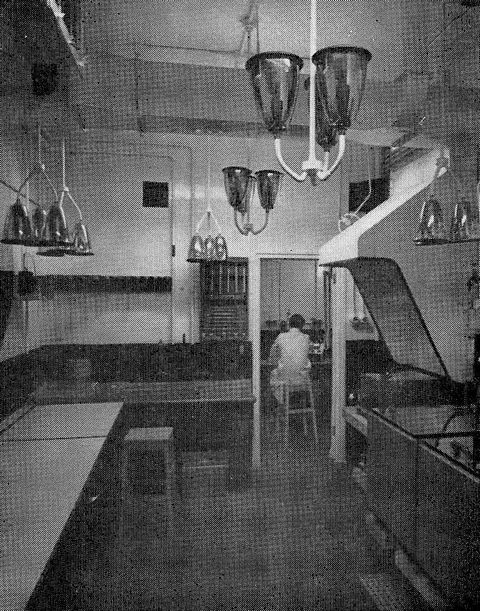
The Indirect Lighting Enables
Three Different Safelights to be Used.
They are Fitted in the Funnel-Like Containers Shown. |
|
|
The physics sections of the
laboratory deal with the three main problems in photographic
material production
Investigation of materials themselves,
Researches in processes such as coating,
Investigations of the special problems in colour photography.
This section includes a drawing
office and a small experimental workshop while, in another part
of the building, a fully equipped engineering workshop with all
the latest machine tools and automatic lathes in charge of skilled
mechanics can produce prototypes of commercial apparatus if needed,
or machines for use in other parts of the laboratory.
Analysis, of course, plays
a very prominent part in both research and the testing of materials
and we were particularly interested in the use made of the most
modern techniques by means of which, as in colorimetric analysis,
accurate measurement can be made of minute traces of various
substances. Photographic gelatine, for example, is acutely susceptible
to the influences of very small quantities of certain chemicals
and it is only within comparatively recent years that the full
significance of this fact has been appreciated. This is one of
the reasons why the present-day sensitised materials are so reliable
and consistent in their performance.
One of the most important functions
of the laboratory is the preparation of characteristic curves
for the various emulsions being prepared. Step wedge prints are
made under strictly controlled conditions, with automatic sensitometers,
then developed under standardised conditions and the various
densities plotted and subsequently interpreted by a number of
workers. Cleverly designed densitometers enable these curves
to be rapidly plotted in a semi-automatic manner. Incidentally,
in preparing characteristic curves for certain X-ray emulsions,
the step wedge used consists of a number of strips of aluminium
of varying thickness, the thinnest of which is of course completely
opaque to visible light, but transparent to X-rays.
The sensitometry of colour
films is a highly specialised branch of work, to which a great
deal of attention is being given. In the development section
of the laboratory we saw prototypes of new apparatus, which have
been produced to simplify and greatly improve the making of both
duplicate transparencies and the popular Ilfordcolor prints,
which are made from transparencies primarily designed for projection.
A morning spent in these new
research laboratories should convince anyone, in a position to
appreciate the work being done there, that Ilford Limited are
in the forefront of the world's photographic manufacturers, and
have their eye firmly fixed on the future in the development
of the science and art of photography.
|
|
Below are a few photographs dating from around 1964
and provided to me by Terry Brown in January 2020. Terry worked
at the Ramsden Laboratory at the time these photographs were
taken.
The photographs are all of
groups of Terry's colleagues at the Ramsden Laboratory. Many
of these colleagues inter-married and Terry jokingly remarks
that the Ramsden Laboratory was the first marriage bureau in
Brentwood in the 1964/5 era.
Many of the names are known
to Terry but I am witholding them here for their privacy, recognising
that many will still be alive.
|
